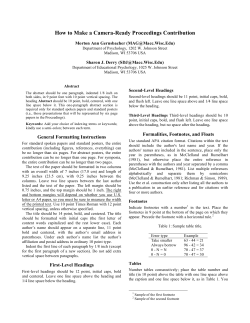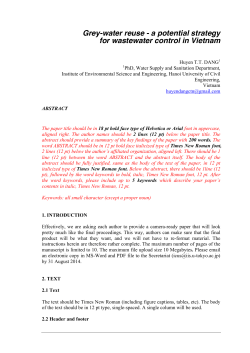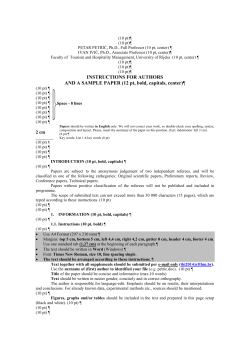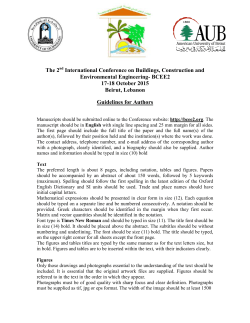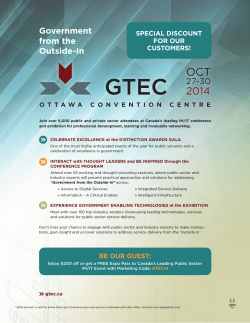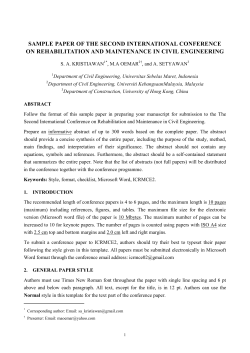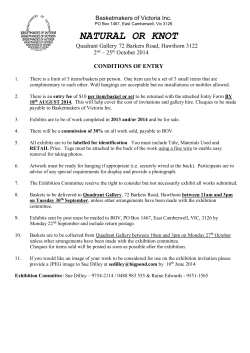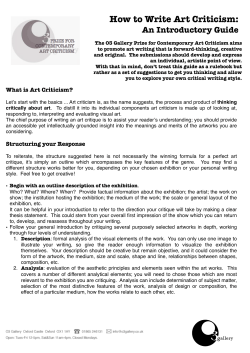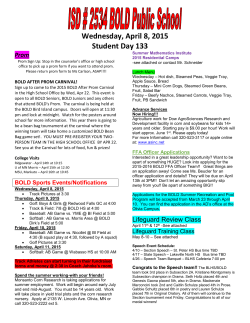
GUIDELINES FOR FULL PAPERS
SOLARTR 2014 Conference & Exhibition 19–21 November 2014, Izmir GUIDELINES FOR FULL PAPERS 1. Manuscripts must be in Word format. 2. All papers must be loadded to the system. 3. The cover page should include the title of the paper and the names and affiliations of the authors. Use all letters of title with bold and left justified 14 pt times new roman. 4. It should include the title and abstract of not more than 200 words and keywords. 5. The text of the manuscript should be prepared in 10 pt Times New Roman, type with 2.5 cm margin 6. 7. 8. 9. on each side, except 4 cm. left margin The whole text must be single spaced. The manuscript text should include at least the following sections, e.g. 1. Introduction, 2.Material and Method, 3.Results, 4. Discussions and 5.Conclusion and followed by References and Appendices (if any). If there are footnotes; these should appear at the bottom of the same page. Footnotes should be single spaced with 10 pt. Tables, figures, graphics and pictures must be numbered. (Table 1. Main actors and their roles, or Graphic 1. Picture 1. or Figure 1. Main stages/tools of the strategy, etc). References should be numbered consecutively in the order in which they are first mentioned in the text and identified in the text, tables or figures and legends by numbers in square brackets [1] and the details should be provided in the References part. The full papers should not exceed 10 pages including references and appendices. PLEASE SEE THE MANUSCRIPT BELOW WHICH MAY BE USED AS AN EXAMPLE www.solartr.org.tr 1|S a y f a SOLARTR 2014 Conference & Exhibition 19–21 November 2014, Izmir Instructions for preparing the full paper to SOLARTR Conference and Exhibition (Times New Roman Bold 14 pt, style: Title) First name Lastname1, Andy Author2 and William Writer2 (12 pt normal, style: Author) 1 2 University of Xyland, Xyland XZY Products, Xyland Corresponding email: Firstname.lastname@domain.org (leave two empty lines after) * Corresponding author: Firstname Lastname Abstract: (heading style: Times New Roman Bold 12 pt, Title) Prepare an informative summary of up to 200 words based on the completed paper. The summary should provide information on the purpose of the study, methods or procedures, results, discussion and concluding remarks or interpretation of the results. If feasible, it should also indicate the meaning or importance of the work. It should be a self-contained statement giving the reader a clear indication of the purpose and content of the paper. Keywords: Solar energy, Conference, Exhibition, Solartr (Leave two empty lines after) 1. Introduction The introduction should present the practical and scientific background for the study or presentation, the hypothesis (es) and a clear statement of the objective(s) of the study/presentation. The maximum length of full papers is ten pages including references, figures and tables. The length of the written paper will have no impact on the allocation of papers to oral or poster presentation. Please use the format described on these pages. The accepted file format is word document. The recommended type face is Times New Roman. All text should be leftjustified 12 pt bold face (style: Normal). Use 12 pt Lowercase bold font for main headings (style: Heading) and 12 pt normal lowercase font for 2nd level headings (style: Heading). Do not use page numbers. www.solartr.org.tr 2|S a y f a SOLARTR 2014 Conference & Exhibition 19–21 November 2014, Izmir 2. Material and methods This section should describe the study design, materials, measuring methods and procedures and statistical methods. Measuring and statistical methods should be mentioned, but for routine methods a reference rather than a description of the method is recommended. The full papers must provide new information on scientific validation, comparative testing, research or development. Please note that commercialism (use of company or product names or logos in the text or illustrations) is not allowed. 3. Results Tables and illustrations (2nd level heading style: Times New Roman Bold 12 pt, Lowercase) In general, figures and other illustrations should be used when they are shorter, clearer, or more effective than explanations in words. If you use shading or color, please check the reproduction by taking a photocopy. Avoid tables and figures which duplicate each other or present superfluous data. If you use a figure, do not include a table for the same information. If the reader needs the table, omit the figure. Substitute a few typical results for lengthy tables when practical. All tables must have suitable captions above the table. Use single line border as presented in Table 2. Tables and figures should be inserted in the text near to the place they are mentioned the first time. Insert figures as ‘picture’ (e.g. wmf or jpg), not as ‘objects’ or spreadsheets. Reduce the resolution of photos etc. to 72 pixels/inch. Table 2.Prevalence of respiratory symptoms. (You may use up to 10 pt font size for table contents) Figure 1. An example of a figure. a) Compaints, b) Symptoms. Equations Equations should be centered and numbered as in the example below: , (1) WhereµT is the mean value of the temperature and σT is the standard deviation of the temperature, σt is the standard deviation of the rate of change of the temperature, and n is the number of level crossings. Use italic symbols for quantities and variables. Punctuate equations with commas or periods when they are part of a sentence. Names and units Only the metric system (SI units) should be used. Frequently used technical terms may be abbreviated after the first time they are mentioned: ”Semi-volatile organic compounds (SVOC) can…” 4. Discussion The most central findings should be put into perspective with the prior knowledge. Possible sources of error, which may have distorted the results, should also be discussed Discussion should also present authors' interpretation of the meaning of the results. The authors are encouraged to make recommendations on the basis of the earlier knowledge and the present results with special reference to practical achievement for sustainable energy use in buildings. 5. Conclusion www.solartr.org.tr 3|S a y f a SOLARTR 2014 Conference & Exhibition 19–21 November 2014, Izmir Acknowledgement A short section may acknowledge assistance. Sources of financial aid should always be noted. References References should be numbered consecutively in the order in which they are first mentioned in the text and identified in the text, tables or figures and legends by numbers in square brackets [1]. If a publication has four or fewer authors, all the authors are listed. If there are more than four, list the first three authors and add "et al". 1. ASHRAE. 1992. ANSI/ASHRAE Standard 55-1992, Thermal Environmental Conditions for Human Occupancy, Atlanta: American Society of Heating, Refrigerating, and Air-conditioning Engineers, Inc. 2. Fanger, P O. 1970. Thermal Comfort.Danish Technical Press. 3. Brundrett, G W. 1990. Criteria for Moisture Control.Butterworths. 4. Hanzawa, H, Melikov, A K, and Fanger P O. 1987. Air flow characteristics in the occupied zone of ventilated spaces.ASHRAE Transactions.Vol. 93 (1), pp 10-20. 5. Kimura, K and Tanabe, S. 1993. Recommended air velocity against combinations of temperature and humidity for sedentary occupants in summer clothing, Proceedings of the 6th International Conference on Indoor Air Quality and Climate - Indoor Air '93, Vol 6, pp 61-66. 6. Raw, G J, Aizlewood, C E, Llewellyn, J, et al. 1999. Indoor air quality and health in 10 office buildings in the UK - a multi-disciplinary study. BRE Report 9911332. www.solartr.org.tr 4|S a y f a
© Copyright 2025
